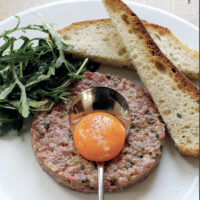
Steak tartare by Tom Aikens
Its origins are lost in the mists of time, but this dish continues to be a fine dining favourite – in France and further afield. Michelin-starred British chef Tom Aikens brings us his version of steak tartare with all the trimmings…
Read: Tom Aiken’s chef highlight
Origins of the steak tartare
According to legend, the Tatar warriors of Mongolia used to tenderise meat by placing it beneath their saddles as they rode, later eating it raw. What’s more likely is that these horsemen used raw meat to protect their steeds from saddle sores while galloping across the Asian steppes.
The first version, though, makes for a far more dynamic story, as imagined in Libération newspaper: “If there’s one dish we can associate with the savagery and brutality of war, it must be steak tartare,” wrote Emmanuel Guillemain d’Echon in a recent article. “With this recipe, you can cook at the same time as waging war. The meat cooks (more or less) beneath the saddle. Crucial, because when you’re staging an invasion, there’s no time to lose.
“You arrive, you disembowel everyone and then you calmly savour your steak as you dismount from your horse. Steak tartare is the meat of barbarians, of savages, or prehistoric man. The exact opposite of civilised man’s pot-au-feu.”
Read: Veal pot-au-feu recipe
It seems the recipe for steak tartare first arrived in France during the second half of the 19th century, when raw horse meat became popular. No one knows when beef steak tartare first appeared on menus, although some historians believe the novelist Jules Verne had a role in its evolution. In his 1875 novel Michel Strogoff, set in Tsarist Russia, he described a Russian dish called koulbat or coulibiac. “Pâté fait avec de la viande pilée et des œufs” (a patty made of pounded meat and eggs). It’s possible that Parisian restaurateurs read this and came up with their own version.
Related recipes:
Recipe card
Steak tartare by Tom Aikens
Ingredients
For the tartare
- 38 g (1⅓ oz) banana shallots, finely chopped
- 60 g (2oz) cornichons chopped
- 60 g (2oz) capers
- ⅓ red chilli finely chopped
- 125 g (4½ oz) Heinz tomato ketchup
- 30 g (1oz) Dijon mustard
- 135 g (4¾ oz) mayonnaise
- A few drops of Tabasco
- A few drops of Worcestershire sauce
- 17 ml (½ fl oz) brandy
- 5 turns of freshly milled pepper
- 2g (⅓ tsp) salt
- About 350g (12½ oz) sirloin steak, trimmed and diced. You’ll need 80g (2¾ oz) per person
- Chopped chives and parsley
- 4 eggs
For the lemon vinaigrette
- 75 ml (2½ fl oz) lemon juice
- 25 ml (¾ fl oz) white wine vinegar
- A pinch of lemon zest
- 15 g (½ oz) sugar
- 6 g (1/5oz) Dijon mustard
- 200 ml (6¾ fl oz) vegetable oil
- 100 ml (3⅓ fl oz) olive oil
- 2 g (⅓ tsp) salt
- White pepper
Instructions
- Sear the beef on top of some oiled paper.
- Remove once the meat is golden brown and chill.
- Trim off all the seared beef, and cut into 10cm long pieces. Wrap and freeze.
- When semi-frozen, cut into 1cm-thick slices and then dice into 1cm-square pieces.
- Weigh out 80g (2¾ oz) and seal in plastic cling wrap bags. It‘s important to keep it for no more than one day before eating.
- When you come to make the beef tartare, mix the sauce ingredients together and use only enough sauce to bind the meat so it holds its shape. Add around 1 tsp of chives and parsley per tartare. Season well with salt and pepper.
- Take the eggs out of their shells carefully and remove all the white from the egg yolk. Soft steam them at 65°C (150°F) for 45 minutes.
- Serve with toasted juniper powder and some salt.
To serve
- Place the beef tartare in a large, flat, round ring, smoothing over the top so it‘s nice and flat.
- Toss some rocket salad with the lemon vinaigrette and place on the side of the plate.
- Place the slow-cooked egg on top of the beef. Serve with two pieces of sour dough toast.
Recipe courtesy of Tom Aikens
Did you enjoy the recipe? Let us know in the comment section below.
Enjoy Taste of France? Well you’re in luck as Taste of France Issue Five is out of the oven!
Latest posts:
- Fabien Ferré: Jumping from 0 to 3 Michelin Stars
- Sardines and onions summer tart
- Brocciu-stuffed sardines
- Mayors banquet: 2 Tonnes of Salmon & 33,000 Bottles of Wine
- Duck liver flan with port coulis
Lead photo credit : Published in Taste of France Issue 3
Share to: Facebook Twitter LinkedIn Email
More in Michelin Starred Chef Recipe, Michelin-star, Recipe from a michelin star chef, Steak tartare, Tom Aikens, Traditional French Recipe








REPLY
REPLY